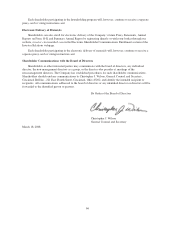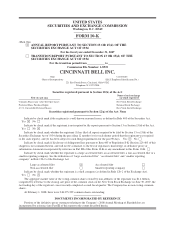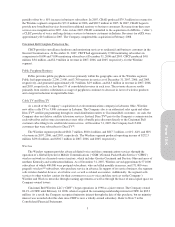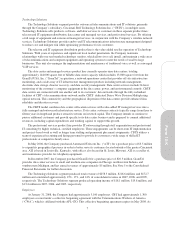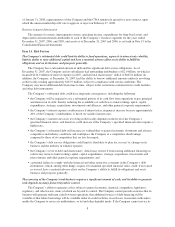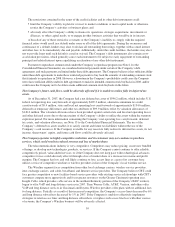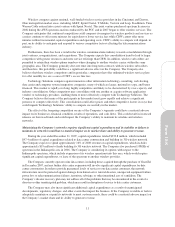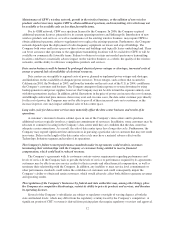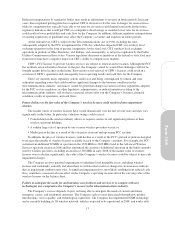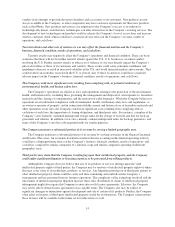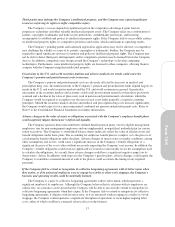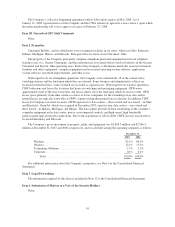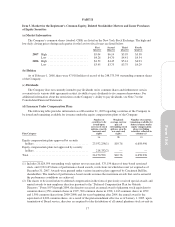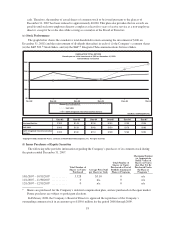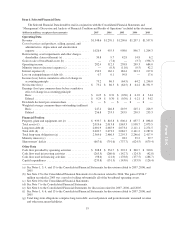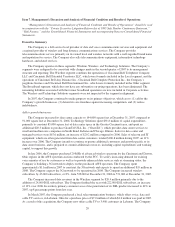Cincinnati Bell 2007 Annual Report Download - page 90
Download and view the complete annual report
Please find page 90 of the 2007 Cincinnati Bell annual report below. You can navigate through the pages in the report by either clicking on the pages listed below, or by using the keyword search tool below to find specific information within the annual report.The restrictions contained in the terms of the credit facilities and its other debt instruments could:
•limit the Company’s ability to plan for or react to market conditions or meet capital needs or otherwise
restrict the Company’s activities or business plans; and
•adversely affect the Company’s ability to finance its operations, strategic acquisitions, investments or
alliances, or other capital needs, or to engage in other business activities that would be in its interest.
A breach of any of these restrictive covenants or the Company’s inability to comply with the required
financial ratios would result in a default under some or all of the debt agreements. During the occurrence and
continuance of a default, lenders may elect to declare all outstanding borrowings, together with accrued interest
and other fees, to be immediately due and payable. Additionally, under the credit facilities, the lenders may elect
not to provide loans until such default is cured or waived. The Company’s debt instruments also contain cross-
acceleration provisions, which generally cause each instrument to be subject to early repayment of outstanding
principal and related interest upon a qualifying acceleration of any other debt instrument.
Payments to repurchase common stock under the Company’s repurchase program (see Note 11 to the
Consolidated Financial Statements) are considered restricted payments under certain of the Company’s debt
agreements, and such payments are limited under these debt agreements. The Company believes it has sufficient ability
under these debt agreements to make these restricted payments to buy back the amounts of outstanding common stock
that it intends to repurchase in 2008. However, a downturn in the Company’s profitability could cause the Company
not to have sufficient ability under its debt agreements to make its intended common stock buybacks in 2008, and/or
could cause the Company not to be able to make additional common stock buybacks in the future.
The Company’s future cash flows could be adversely affected if it is unable to realize fully its deferred tax
assets.
As of December 31, 2007, the Company had a net deferred tax asset of $596.2 million, which includes U.S.
federal net operating loss carryforwards of approximately $492.3 million, alternative minimum tax credit
carryforwards of $9.4 million, state and local net operating loss carryforwards of approximately $134.6 million,
deferred tax temporary differences and other tax attributes of $99.9 million, offset by valuation allowances of
$140.0 million. The valuation allowances have been provided against certain state and local net operating losses
and other deferred assets due to the uncertainty of the Company’s ability to utilize the assets within the statutory
expiration period. For more information concerning the Company’s net operating loss carryforwards, deferred
tax assets, and valuation allowance, see Note 13 to the Consolidated Financial Statements. The use of the
Company’s deferred tax assets enables it to satisfy current and future tax liabilities without the use of the
Company’s cash resources. If the Company is unable for any reason to fully realize its deferred tax assets, its net
income, shareowners’ equity, and future cash flows could be adversely affected.
The Company operates in highly competitive industries and its customers may not continue to purchase
services, which could result in reduced revenue and loss of market share.
The telecommunications industry is very competitive. Competitors may reduce pricing, create new bundled
offerings, or develop new technologies, products, or services. If the Company cannot continue to offer reliable,
competitively priced, value-added services, or if the Company does not keep pace with technological advances,
competitive forces could adversely affect it through a loss of market share or a decrease in revenue and profit
margins. The Company has lost, and will likely continue to lose, access lines as a part of its customer base
utilizes service of competitive wireline or wireless providers in lieu of the Company’s local wireline service.
The Wireline segment faces competition from other local exchange carriers, wireless service providers,
inter-exchange carriers, and cable, broadband, and Internet service providers. The Company believes CBT could
face greater competition as new facilities-based service providers with existing service relationships with CBT’s
customers compete more aggressively and focus greater resources on the Greater Cincinnati operating area.
Insight Cable, which provides cable service in the northern Kentucky portion of the Company’s ILEC territory,
began to offer VoIP and long distance services in 2007. Time Warner Cable, AT&T, Verizon, and others offer
VoIP and long distance services in Cincinnati and Dayton. Wireless providers offer plans with no additional fees
for long distance. Partially as a result of this increased competition, the Company’s access lines decreased by 6%
and long distance subscribers decreased by 1% in 2007. If the Company is unable to effectively implement
strategies to retain access lines and long distance subscribers, or replace such access line loss with other sources
of revenue, the Company’s Wireline business will be adversely affected.
10


